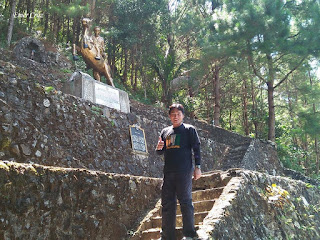The infamous Battle of Tirad Pass was also referred by some historians as the "Philippine Thermopylae". It was a battle that was held in Northern Luzon particularly in the town of Gregorio Del Pilar, Ilocos Sur formerly known as Concepcion during the time of Philippine-American War which was fought on December 2, 1899. It involved 60 Filipino soldiers under the command of Brigadier General Gregorio del Pilar against the 500 Americans commanded by Major Peyton C. March. The main purpose was to delay the Americans from advancing and to ensure that Emilio Aguinaldo and his troops can escape from pursuers.
After more than five hours of battle, the Americans began to felt the scorching heat of the midday sun and decided to rest for a while amidst the rocks. Later that day, the search party had succeeded their task, and the Americans fell upon the rear of the outnumbered defenders, defeating them. Over the course of the battle, 52 of the 60 Filipinos were killed. Among the dead was General del Pilar, shot through the neck at the height or end of the struggle.
The American's looted Del Pilar's possessions where they stripped him bare of his military decorations, uniform, and his personal belongings, leaving him, as the eyewitness, correspondent Richard Henry Little wrote, "We carved not a line and we raised not a stone, But we left him alone with his glory".
Del Pilar's diary with its poignant final entry, written on the night of December 1 was also recovered which says:
"The General has given me a Platoon of available men and has ordered me to defend this Pass. I am aware what a difficult task has been given me. Nevertheless, I feel that this is the most glorious moment of my life. I am doing everything for my beloved country. There is no greater sacrifice."
Del Pilar's corpse lay unburied for three days. American officer Lieutenant Dennis Quinlan, with a group of Igorots, later buried his body and left a plaque, "Gen. Gregorio del Pilar, Died December 2, 1899, Commanding Aguinaldo's Rear Guard, An Officer and a Gentleman."
In honour of Del Pilar's heroism, the Philippine Military Academy was named Fort Del Pilar and the town's name of Concepcion was changed to Gregorio del Pilar wherein a historical marker placed at the site of the battle.
 |
| JP Pring, Lloyd, Barry and Pot |
***Some texts and wordings were copied from the following references:
1.) Gregg Jones (2012). Honor in the Dust: Theodore Roosevelt, War in the Philippines, and the Rise and Fall of America's Imperial Dream. Penguin Publishing Group. pp. 135–136. ISBN 978-1-101-57512-3.
2.) Joaquin, Nick. A Question of Heroes.
3.) Moorfield Storey; Marcial Primitivo Lichauco (1926), The Conquest of the Philippines by the United States, 1898–1925, G. P. Putnam's sons, p. 109
4.) Louis Freeland Post; Alice Thatcher Post; Stoughton Cooley (1899). "The Death of Gregorio Del Pilar". The Public. Louis F. Post. 2–11.
5.) Raymond Landon Bridgman (1903), Loyal traitors: a story of friendship for the Filipinos, J.H. West (Full text, from the library of the University of California)





so historical! keep it up!
ReplyDeleteThank you so much Mam.
Delete